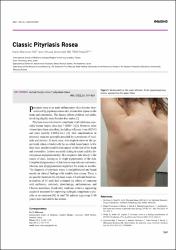Classic pityriasis rosea
Künye
Mahroum, N. ve Shoenfeld, Y. (2022). Classic pityriasis rosea. Israel Medical Association Journal, 24(8), 549-549.Özet
P
ityriasis rosea is an acute inflammatory skin disorder characterized by papulosquamous skin lesions that appear on the
trunk and extremities. The disease affects children and adults,
involving slightly more females than males [1].
Pityriasis rosea is known to complicate viral infections, especially human herpes virus type 7 (HHV-7) [2]. However, other
viruses have been described, including influenza virus (H1N1)
and more recently SARS-CoV-2 [3]. Skin manifestations in
pityriasis rosea are generally preceded by a prodrome of headache and malaise. In most cases, skin eruption starts on the upper trunk (chest or back) with the so-called . A few
days later, smaller round lesions appear on the rest of the trunk
and extremities. Lesions are rarely itching in nature and the disease passes asymptomatically. Skin eruptions fade slowly in the
course of days, leaving no or slight pigmentation of the skin.
Complete disappearance of skin lesions may take several weeks,
whereas skin dyspigmentation might last for weeks to months.
The diagnosis of pityriasis rosea is straightforward and based
mainly on clinical findings with suitable time course. There is
no specific treatment for pityriasis rosea. A Cochrane based meta-analysis of 14 trials that evaluated the effects of treatment
with antibiotics, antivirals, phototherapy, antihistamines, and
Chinese medicines, found only moderate evidence supporting
acyclovir treatment for improving itchingin comparison to placebo or no treatment [4]. In total 761 patients (age range 2–60
years) were included in the studies.


















